Examining Free Agency Since 2016

Free agent position players have fared pretty well in free agency recently. (via Ian D’Andrea)
When did you realize free agency was in trouble? I bet it was during the 2017–2018 offseason. But was it in early January 2018 when Travis Sawchick realized that of FanGraphs’ top 20 free agents, only five had signed? Was it in February of 2018, when news broke that unsigned players would hold their own spring training camp? Or did it take until March, when Neil Walker received $4 million despite having produced seven straight years of at least 2 WAR?
During that offseason, the average free agent waited 10 days longer to sign a contract:

A week-and-a-half increase in average wait time across 400+ free agents got our collective attention. Looking back since 2010, it’s clear that free agents had been signing later and later, but it’s also clear that something snapped in 2017. We all felt it.
One year later, continuing market tremors influenced a spike in contract extensions as players realize it’s scary out there without a job. Evan Longoria expressed his frustration and Justin Verlander called the system “broken.” Hell, even Mike Trout got spooked! If the best player this side of Mickey Mantle is worried about finding a job in two years, no wonder David Freese signed a deal worth less than his club option.
Plenty of hands have been wrung about the current state of labor in major league baseball, but I wanted to see details. I was curious which kinds of players were affected the most by the dramatic shift in free agency that occurred between the 2016 and 2017 offseasons, and I was curious whether the 2018 offseason corrected at all for the 2017 one.
I measured the two primary characteristics of free agency:
- How long it takes players to sign a contract. The longer this time is, the more bored we as fans get, and the longer players have to wait to secure their next job. I measured time-to-sign as the number of days between November 1 of each offseason and the day the player signed his contract. I used Baseball Reference for data; here’s an example.
- How much money a player signs for. To find this out I pulled data from MLB Trade Rumors’ free agency pages; here’s an example. Because fans are concerned mostly with guaranteed major league money, I counted minor-league deals as $0. I also adjusted each deal for inflation so I could compare across years.
Not all free agents are treated equally. Manny Machado hit free agency as a stud 26-year-old shortstop and third baseman, while Andrew McCutchen reached it as a pretty good 32-year-old corner outfielder. How long a player waits to sign and how much money he signs for is a function of many variables, not all of which can be measured, but the ones I looked at were position, talent level, and age at time of signing.
I defined a player’s talent level using his rWAR total in the three years prior to hitting the market. I grouped players into the following buckets, based on their position:
| Position | Three-Year WAR Total | Group |
|---|---|---|
| Position Player or Starting Pitcher | Less than 1.5 | Scrub |
| Between 1.5 and 4.4 | Role Player | |
| Between 4.5 and 7.4 | Solid Starter | |
| Between 7.5 and 10.4 | Good Player | |
| Between 10.5 and 13.4 | All-Star | |
| Between 13.5 and 16.4 | Superstar | |
| 16.5 or greater | MVP | |
| Relief Pitcher | Less than 1 | Scrub |
| Between 1 and 1.9 | Role Player | |
| Between 2 and 4.9 | Good Player | |
| 5 or greater | Superstar |
I also classified players into the following buckets based on how old they were when they signed their deal:
- 27 years old or younger
- Between 28 and 30
- Between 31 and 33
- Between 34 and 36
- Between 37 and 39
- Between 40 and 42
- 43 or older
Here are some examples:
| Name | Offseason Signed | Age Group | Position | Three-Year rWAR Total | Classification | Contract |
|---|---|---|---|---|---|---|
| Joaquin Benoit | 2016 | 37 – 39 | Relief Pitcher | 4.9 | Good Player | $7.8M |
| Jaime Garcia | 2017 | 31 – 33 | Starting Pitcher | 6.0 | Solid Starter | $10.24M |
| Manny Machado | 2018 | <= 27 | Position Player | 16.2 | Superstar | $300M |
I then found groups for which the 2016, 2017, and 2018 offseasons all had representatives, so I could see how each was affected across all three years. For each group, I computed the average time to sign and the median contract value they signed for.
Classifying players in these ways is a good start but has has many limitations. Among them:
- Some of these groups are small. Many consist of one or two players, which makes it hard to discern conclusive trends.
- These groups are what I consider to be reasonable. Others may disagree. If you change the buckets, the analysis will change, too.
- Players are individuals. Putting them into a data bucket ignores characteristics like injury history, work ethic, and their career path until that point. These elements and more factor into how much money teams offer them and how much money they’ll accept.
- Teams and players often care about more than just total contract value. Teams sometimes care about average annual value for the purpose of getting under the luxury tax. Some players also care more about AAV. Others sometimes care more about contract length. Some players like opt-out clauses, which I didn’t tackle. And some players prioritize the location of the team they play for.
- There is some survivor bias at play here because I’m looking only at players who received contracts.
- I’m looking only at groups with representatives in all three offseasons. Several others had representatives in two of the three.
Despite these and other drawbacks, one of my favorite sayings is along the lines of “An approximate answer to the right question is worth a great deal more than a precise answer to the wrong question.”
League-Wide Trends
Given the groups above, for each offseason, I calculated how many groups fell into each of the following four categories:
- Waited the same amount of time or shorter and signed for less money
- Waited the same amount of time or shorter and signed for the same amount of money or more
- Waited longer and signed for less money
- Waited longer and signed for the same amount of money or more
The following chart tells the tale:
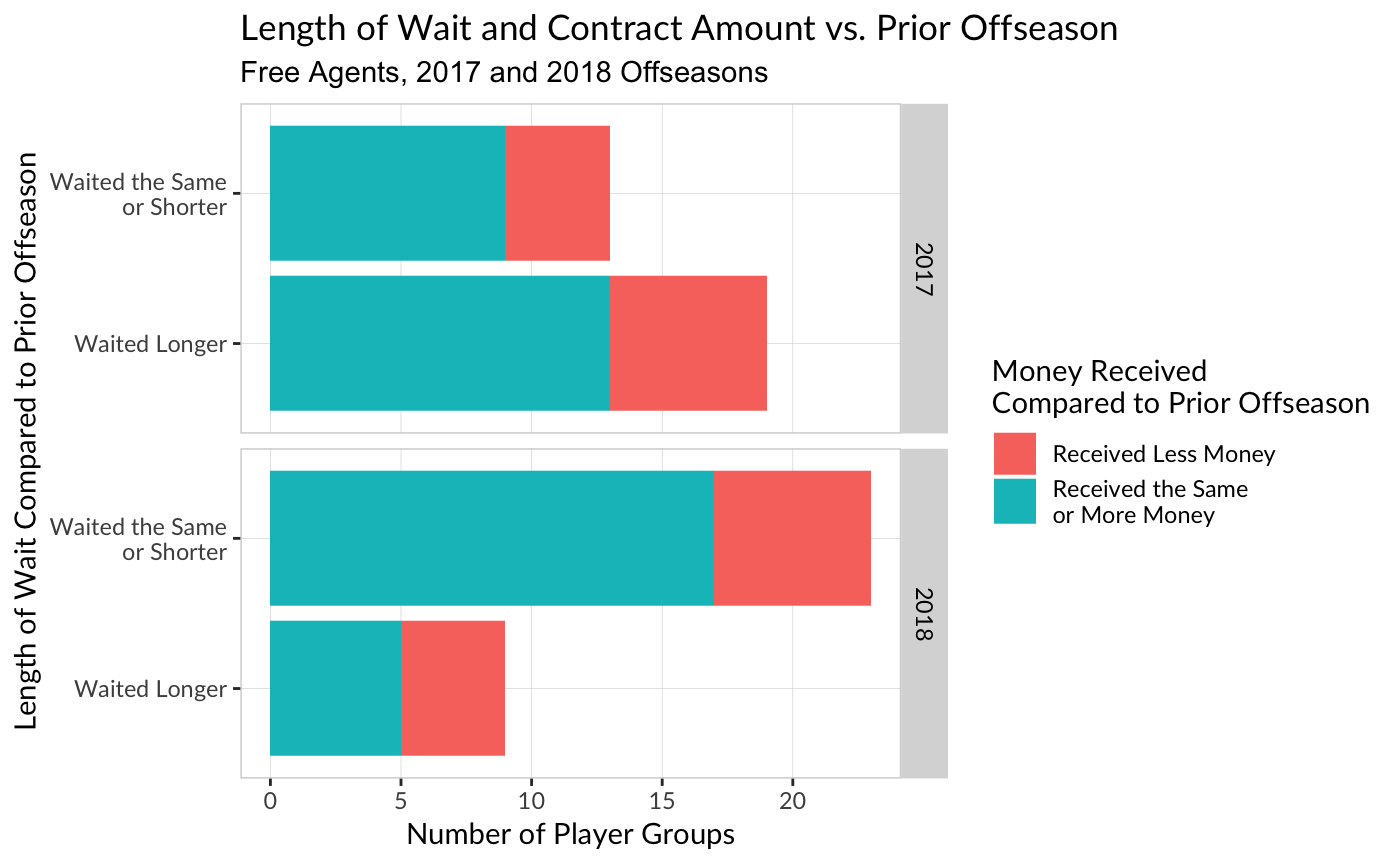
We see confirmation that in 2017, most groups waited longer to sign than in 2016. But based on the median salary of the group, most groups received the same amount of money or more. They didn’t give up much. In 2018, more groups signed earlier than they did in 2017. Of these groups, however, most received the same amount of money or more.
This graph can be misleading, however, because it doesn’t show the magnitude of any differences. The following graph does. It shows, for the 2017 and 2018 offseasons, the difference in average time to sign and median salary for each group. I’ve labeled the same three groups in each offseason:

In 2017, the bulk of the groups are to the right of the x=0 line, showing again that most of the groups waited longer to sign than they did in 2016. And while most groups hover around the y=0 line, meaning their median salary didn’t change much, two groups stand out. The typical “Position Player, All-Star, 31 – 33” signed for much less money than in 2016, whereas the typical “Position Player, Good Player, 28 – 30” signed for much more money. I’ll cover these groups in detail below.
In 2018, the tide turned. Most groups are to the left of the line x=0, indicating more groups signed earlier in 2018 than they did in 2017. Did they give up money in exchange for earlier job security? One group seems to have (Position Player, Good Player, 28 – 30) but the rest, not so much.
Now let’s dig into the details.
Position Players
The following graph shows how groups of position players fared:
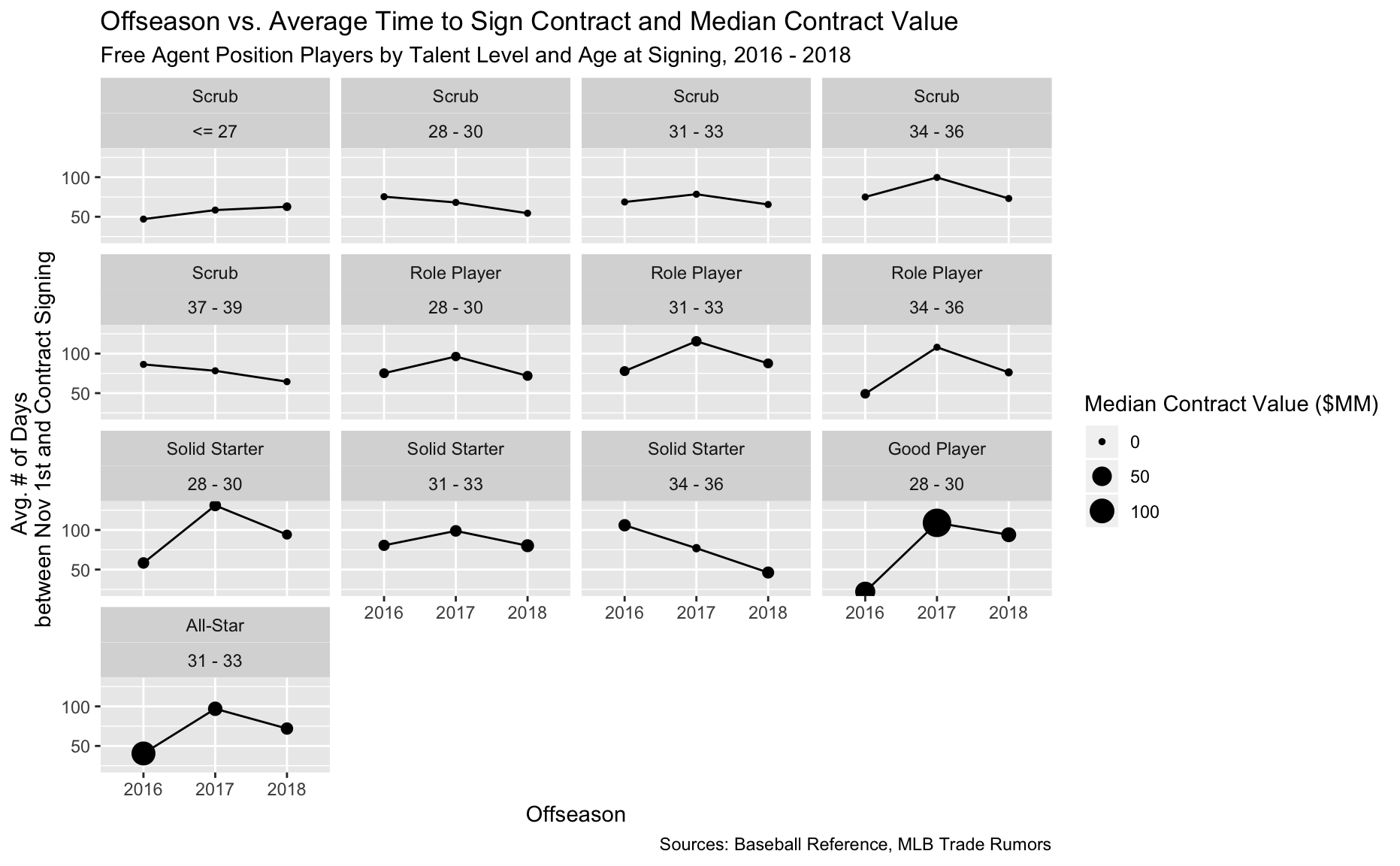
Nearly all groups waited longer to sign in 2017 than they did in 2016, and nearly all waited less in 2018 than in 2017. The first group that catches my eye is the “Good Player, Age 28 – 30” group. In 2017 these players not only waited much longer to sign, but also signed for much more money than players in either 2016 or 2018. Let’s zoom in:
- In 2016, Josh Reddick was 30 and had accumulated 9.2 WAR the previous three years. He waited 22 days to sign a $54.93 million deal with Houston. (Remember, these contract values are adjusted for inflation.)
- In 2017, Eric Hosmer was 28 and had accumulated 8.9 WAR the previous three years. He waited 109 days to sign a $147.5 million deal with San Diego. This 87-day “delay” is the longest in my dataset; however, it seems to have worked for Hosmer in terms of total contract value.
- In 2018:
- Yasmani Grandal was 30 and had accumulated 8.2 WAR the previous three years. He waited 73 days to sign an $18.25 million deal with Milwaukee. This seems low, but he prioritized AAV over total guaranteed money. That’s part of the subjectivity I mentioned above. Also remember that the Mets offered him $60 million, which would’ve been comparable to the Reddick deal. By rejecting this deal, Grandal pulled the median salary for his group way down.
- Marwin Gonzalez was 30 and had accumulated 7.9 WAR the previous three years. He waited 115 days to sign a $21 million deal with Minnesota.
For these players, you could argue that 2017 was better than 2016. Despite waiting much longer to sign, Hosmer got paid far more than Reddick did. But his contract likely was a special case. In 2018 the market for these kinds of players returned to something resembling sanity, although Grandal and Gonzalez still waited much longer than Reddick did to sign.
The “All-Star, Age 31 – 33” group is also interesting:
- 2016 featured two such signings:
- Yoenis Cespedes was 31 and coming off 13.4 WAR the previous three years. He waited 29 days to sign a $115 million contract.
- Justin Turner was 31 and coming off 13 WAR the previous three years. He waited 52 days to sign a $67 million contract.
- In 2017, Todd Frazier was 32 and coming off 10.6 WAR. That’s a one-win-per-year difference between him and his 2016 counterparts, yet he waited 97 days to sign a deal worth $17.4 million. This bargain price made Jay Jaffe’s list of the most team-friendly signings of that offseason. (For what it’s worth, Frazier’s deal was the one that made me sit up and take notice of the new era of free agency.)
- In 2018, Brian Dozier was 32 and coming off a three-year-WAR total of 11.7. He waited 72 days to sign a deal worth $9 million. This is a case where injuries may have played a role in lowering a player’s contract. Dozier was hurt most of his walk year and likely accepted a lower valuation to prove his worth again.
Here’s a clear indication of teams shying away from certain kinds of players. Perhaps Cespedes’ injury history (he’s played in only 50 percent of the Mets’ games during his contract) gave Sandy Alderson cold feet when it came to signing Frazier. And although Dozier signed earlier than Frazier, he appears to have given up some money to do so, even if it was due to injuries.
Starting Pitchers
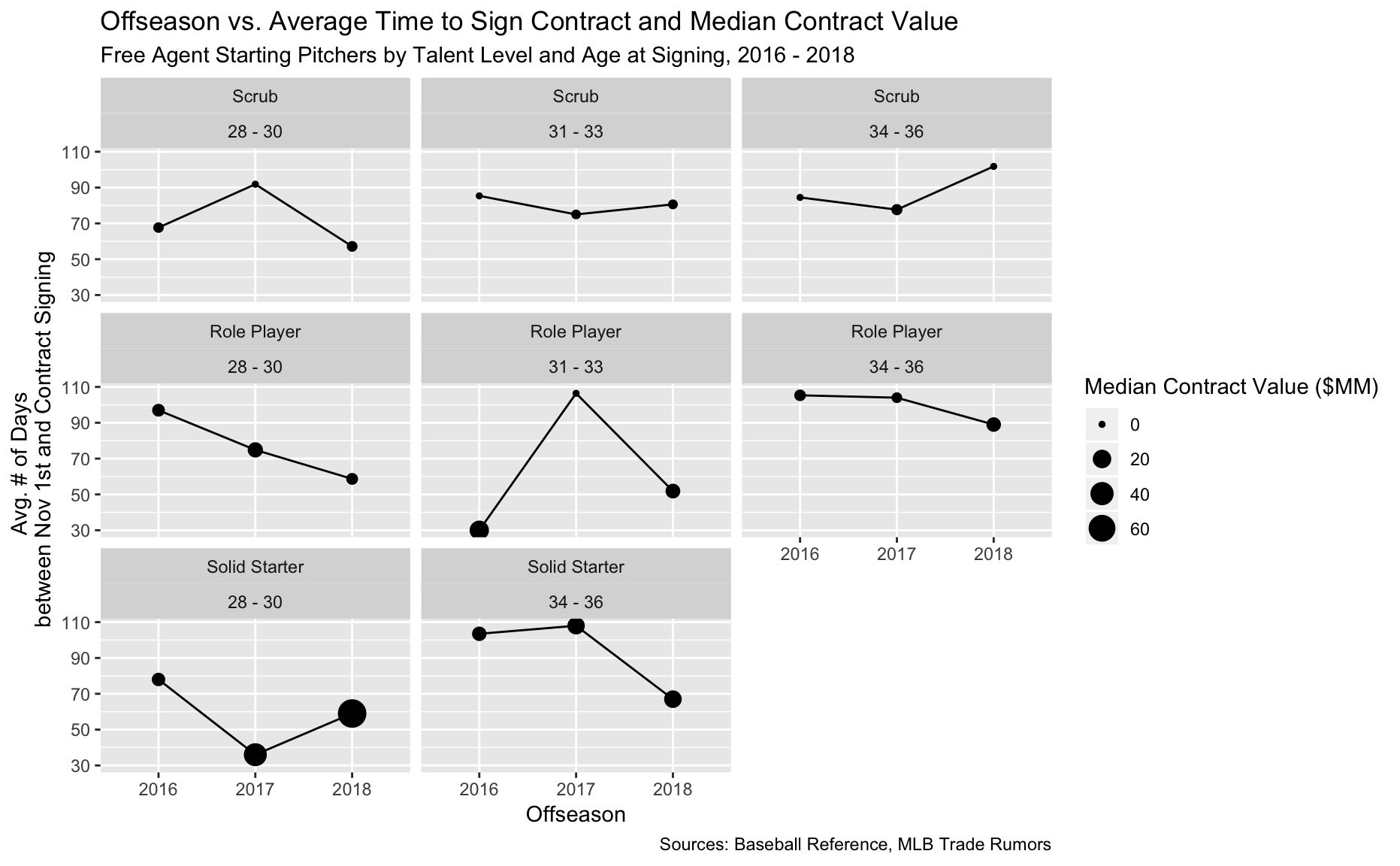
The group that stands out is “Role Players, Age 31 – 33”. The 2016 group is represented by one man: Edinson Volquez, who at 33 waited 30 days to sign a $23 million deal. Not bad. The 2017 group includes many more players:
| Name | Age | Three-Year WAR | Days to Sign | Contract* |
|---|---|---|---|---|
| Mike Fiers | 33 | 1.8 | 37 | $6.1M |
| Tyson Ross | 31 | 2.9 | 56 | Minor-league Deal |
| Andrew Cashner | 31 | 3.1 | 105 | $16.3M |
| Wade Miley | 31 | 2.4 | 106 | Minor-league Deal |
| Jeremy Hellickson | 31 | 3.7 | 137 | Minor-league Deal |
| Clay Buchholz | 33 | 2.4 | 140 | Minor-league Deal |
| Yovani Gallardo | 32 | 4 | 164 | $2.0M |
It’s as if all at once, every single team decided to not spend money on these kinds of players. The average time to sign of 106.4 days is 76.4 days longer than Volquez took; this increase is the second-highest in my dataset.
How about 2018?
| Name | Age | Three-Year WAR | Days to Sign | Contract* |
|---|---|---|---|---|
| Hyun-Jin Ryu | 32 | 3.8 | 13 | $17.9M |
| Garrett Richards | 31 | 1.5 | 36 | $15.5M |
| Lance Lynn | 32 | 3.7 | 47 | $30.0M |
| Trevor Cahill | 31 | 2.8 | 49 | $9.0M |
| Matt Shoemaker | 32 | 2.7 | 57 | $3.5M |
| Hector Santiago | 31 | 1.7 | 70 | Minor-league deal |
| Wade Miley | 32 | 1.5 | 91 | $4.5M |
For whatever reason, in 2018 this group did better than their 2017 counterparts in both time-to-sign and dollars signed for. Still, it’s just one group of many, and the typical member of their group still got paid less than Volquez did.
Another interesting group is Solid Starters aged 28 – 30:
- In 2016 Tyson Ross (age 30, 6.8 WAR the previous three years) waited 78 days to sign a deal worth $6.2 million at age 30.
- In 2017 Tyler Chatwood (age 28, 5.5 WAR the previous three years) waited 36 days to sign a deal worth $38.9 million at age 28.
- 2018 saw a feast-or-famine approach:
- Patrick Corbin (age 29, 7.2 WAR the previous three years) waited 36 days to sign a $140 million deal at age 29.
- Drew Pomeranz (age 30, 7.2 WAR the previous three years) waited 82 days to sign a $1.5 million deal at age 30.
Chatwood’s deal definitely counteracted the “free agency is broken” narrative of the 2017 offseason. He was a less talented pitcher than Ross but signed earlier and for more money. The two years’ difference in age could’ve had something to do with it.
I don’t think we can make any conclusions about this group’s trends in 2018 because Corbin and Pomeranz both are special cases. Corbin had an excellent walk year that saw him place fifth in the NL Cy Young voting. Meanwhile Pomeranz battled injuries and ineffectiveness that led to a bullpen demotion. I can understand why each player got the contract he got, despite being nearly the same age and worth the same amount of WAR from 2016–2018. As I mentioned earlier in this article, each player is an individual who has his own story.
Relief Pitchers
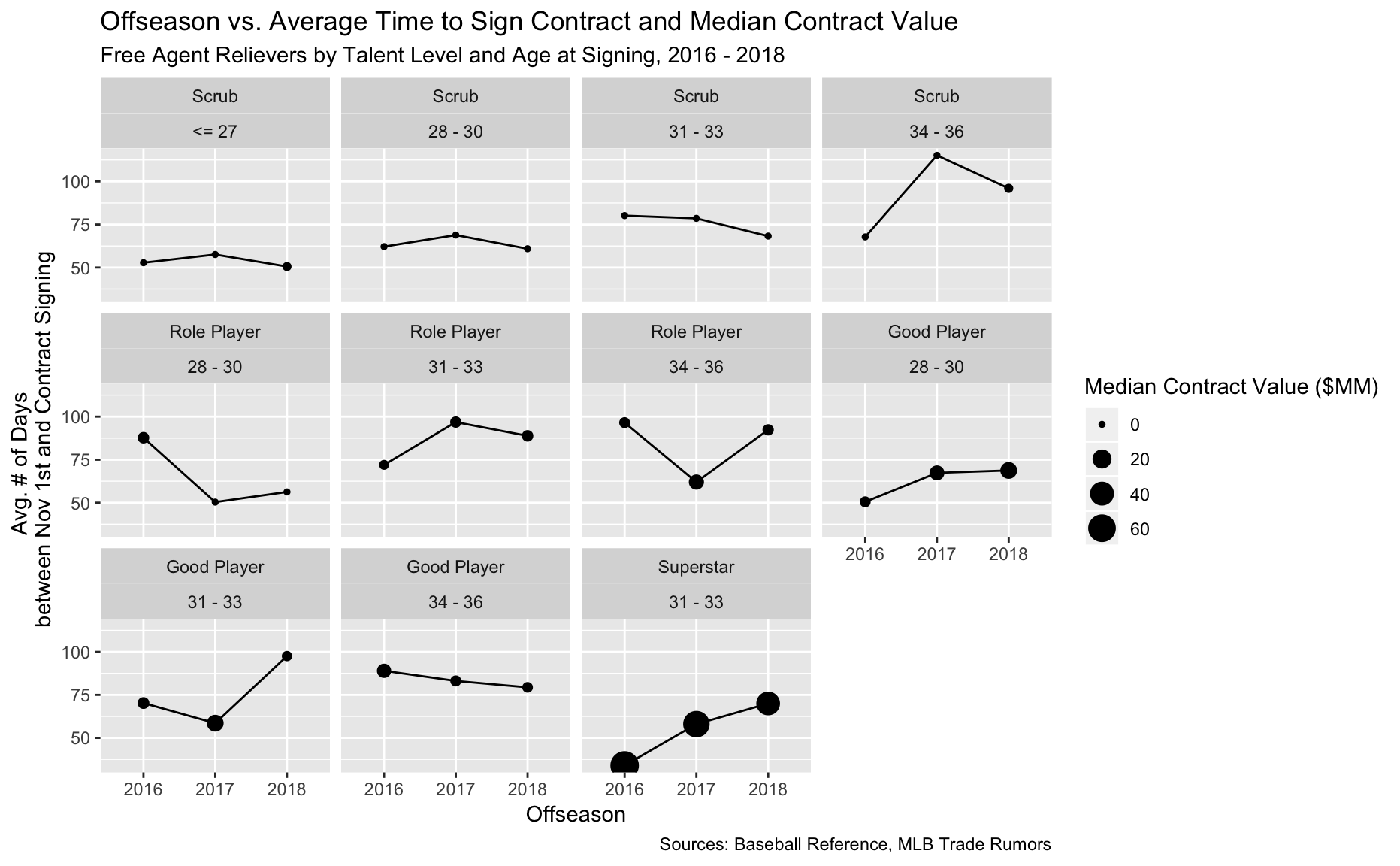
Scrub relievers aged 34 – 36 had a heck of a time finding a job in 2016 …
| Name | Age | Three-Year WAR | Days to Sign | Contract* |
|---|---|---|---|---|
| Sean Burnett | 34 | 0 | 41 | Minor-league deal |
| Dustin McGowan | 35 | 0.4 | 41 | $1.8M |
| Jim Henderson | 34 | -0.5 | 86 | Minor-league deal |
| Matt Albers | 34 | 0.2 | 155 | Minor-league deal |
… but in 2017 these guys had to wait even longer:
| Name | Age | Three-Year WAR | Days to Sign | Contract* |
|---|---|---|---|---|
| Jumbo Diaz | 34 | -0.1 | 70 | Minor-league deal |
| Jason Motte | 36 | 0.9 | 109 | Minor-league deal |
| Jesse Chavez | 34 | 0.9 | 113 | $1M |
| Oliver Perez | 36 | 0.3 | 150 | Minor-league deal |
| Dustin McGowan | 36 | -0.4 | 157 | Minor-league deal |
(Note that the graph counts Edward Mujica in 2017 (92 days to sign) but the table doesn’t list him because I didn’t have a salary in the dataset.)
How about in 2018?
| Name | Age | Three-Year WAR | Days to Sign | Contract* |
|---|---|---|---|---|
| John Axford | 36 | 0.5 | 106 | Minor-league deal |
| Tony Sipp | 35 | 0.6 | 134 | $1.25M |
The graph counts Mike Zagurski in 2018 (48 days to sign) but isn’t listed in the table for the same reason as Mujica.
The last group I’ll look at is the “Superstar, Age 31 – 33” group. Here we see a trend unfolding before our very eyes:
- In 2016 Mark Melancon (7.2 WAR the previous three years, age 32) waited 34 days to sign a deal worth $64.9 million.
- In 2017 Wade Davis (7.2 WAR the previous three years, age 32) waited 58 days to sign a deal worth $53.2 million.
- In 2018 Zack Britton (5.9 WAR the previous three years, age 31) waited 70 days to sign a deal worth $39 million.
Relievers of this age and caliber are waiting longer to sign and doing so for less money. Melancon spent time on the IL in 2017 and 2018 and lost his closer job to Sam Dyson. Wade Davis was good overall in his first year with Colorado but had a poor summer, allowing 23 earned runs in 24.1 innings from June to August. Britton has yet to build a narrative with the Yankees this year, but he also missed most of the 2018 season with an injury and was a bit wild when he returned.
Notably, Craig Kimbrel is also in this group. At age 31 he totaled 6.1 WAR in the three years leading up to free agency. As of this writing, he remains unsigned, which is more evidence that teams are increasingly reluctant to pay big money to these kinds of relievers. He’s dropped his asking price from $100 million to something in between Britton’s and Davis’ contracts.
When you zoom back out again, the 2018 offseason marked a retreat from the collective freakout of 2017:
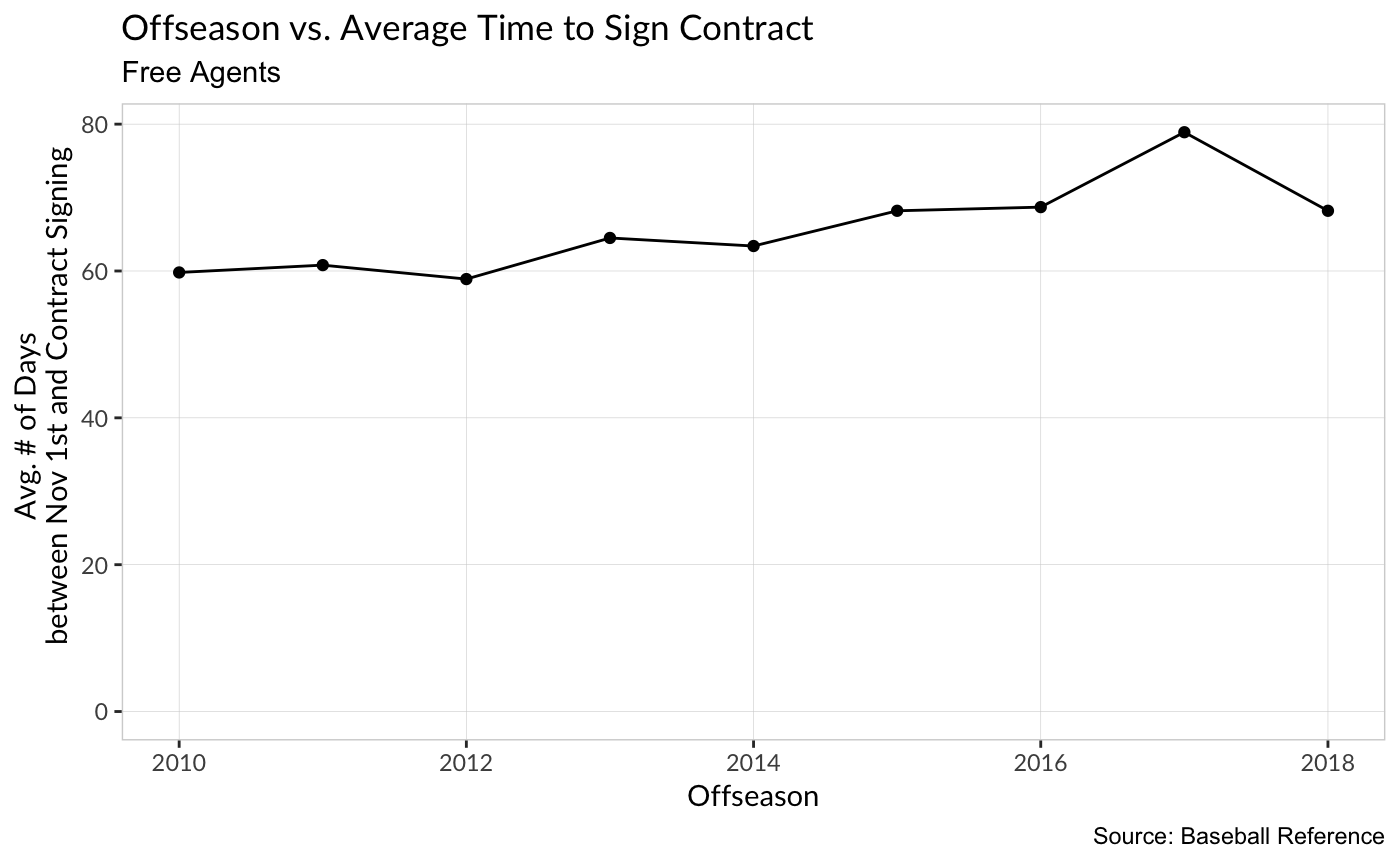
Free agents still take longer to sign than they used to, but we appear to be back to 2015–2016 levels, at least for now. And the players don’t appear to have given up much money in exchange for signing earlier. Of course the devil’s in the details; we saw above how some specific groups of players received less overall. As owners and players think about what they want to discuss in the next round of Collective Bargaining Agreement discussions, Rob Manfred and Tony Clark would do well to remember these details.